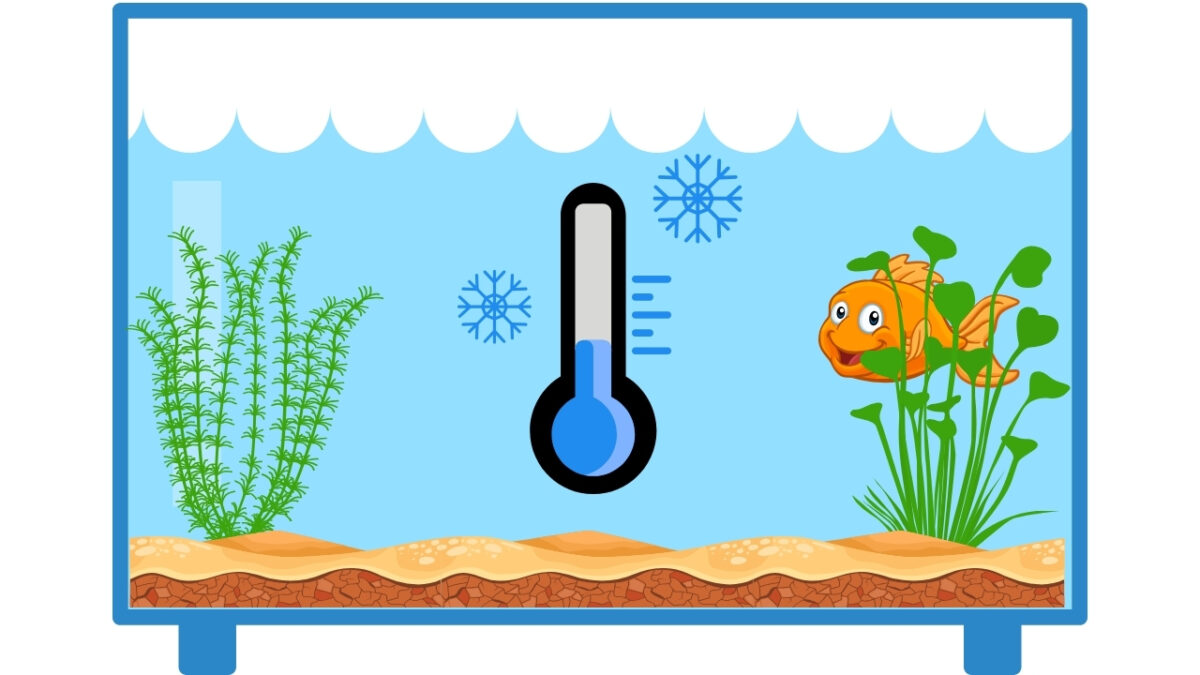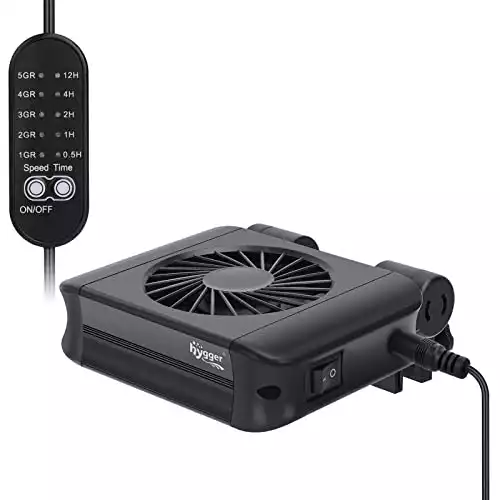
- What Is The Ideal Goldfish Tank Temperature Range?
- 4 Benefits Of Maintaining The Ideal Water Temperature For Goldfish
- Factors Influencing Temperature of Aquarium Water
- How Do You Warm Up Goldfish Water?
- How Do I Cool Down My Goldfish Tank? 4 Simple Options
- Goldfish Breeding
- Closing Thoughts On Ideal Tank Temperature For Goldfish
Goldfish are hardy fish that can tolerate a wide range of temperatures, but did you know that different types of goldfish have different temperature requirements?
What Is The Ideal Goldfish Tank Temperature Range?
For slim-bodied goldfish like the common, comet, and shubunkins the optimum water temperature range is 64°F to 70°F (17.5°C to 21°C).
For fancy goldfish, the optimal range is 68°F to 74°F (20°C to 23°C).
Here’s a guide to the ideal temperature range for each kind of goldfish:
| GOLDFISH TYPE | WATER TEMPERATURE RANGE |
| Black Moore | 68°F to 74°F (20°C to 23°C) |
| Bubble Eye | 68°F to 74°F (20°C to 23°C) |
| Butterfly | 68°F to 74°F (20°C to 23°C) |
| Celestial Eye | 68°F to 74°F (20°C to 23°C) |
| Comet | 64°F to 70°F (17.5°C to 21°C) |
| Common | 64°F to 70°F (17.5°C to 21°C) |
| Egg Fish | 68°F to 74°F (20°C to 23°C) |
| Fantail | 68°F to 74°F (20°C to 23°C) |
| Jikin | 68°F to 74°F (20°C to 23°C) |
| Lionhead | 68°F to 74°F (20°C to 23°C) |
| Oranda | 68°F to 74°F (20°C to 23°C) |
| Pearlscale | 68°F to 74°F (20°C to 23°C) |
| Pompon | 68°F to 74°F (20°C to 23°C) |
| Ranchu | 68°F to 74°F (20°C to 23°C) |
| Ryukin | 68°F to 74°F (20°C to 23°C) |
| Shubunkin | 64°F to 70°F (17.5°C to 21°C) |
| Tamasaba | 68°F to 74°F (20°C to 23°C) |
| Telescopic | 68°F to 74°F (20°C to 23°C) |
| Tosakin | 68°F to 74°F (20°C to 23°C) |
| Veiltail | 68°F to 74°F (20°C to 23°C) |
| Wakin | 64°F to 70°F (17.5°C to 21°C) |
4 Benefits Of Maintaining The Ideal Water Temperature For Goldfish
Goldfish are ectotherms, meaning they rely on the environment around them to regulate their body temperature.
Maintaining a stable water temperature has the following benefits:
1. Health, Immunity, and Longevity
Stable water temperatures keep their immune system firing on all cylinders meaning they can keep fighting off any illnesses and diseases.
It’s also a win-win situation for you, as you (or even worse…..your child) do not have to go through the stress of having a sick pet, nor will you have to pay an expensive vet bill.
Stable water temperatures help young fish develop and grow into healthy adults, so you can enjoy many years to come with them.
2. Healthy Eating Habits
Increasing water temp will speed up their metabolism making them want to eat even more than they already do!
Something you may notice if the temperature is too high and you don’t feed them often enough is your goldfish passing white stringy poop.
Contrary to what you may have read elsewhere, your goldfish doesn’t have an internal parasite. Instead, what you’re seeing is mucus that lines the intestines.
This mucus is there to help protect and move food along the digestive system, but if there’s no food to push through, you might only see this clear or white stringy substance instead.
This is often seen when the goldie is kept with tropical fish rather than other suitable cool water tank mates.
3. Water Quality
More food in = more poop out = more strain on your tank’s nitrogen cycle.
If you’ve just started a new tank and haven’t established the nitrogen cycle yet, or if your filter isn’t up to the job, you could end up with an ammonia spike on your hands.
Warmer water also holds less oxygen than cooler water so you may need to increase surface agitation with an air stone or add some live plants to aerate the water better.
Your goldfish laying still on the substrate or gasping for air at the water’s surface are signs that there isn’t enough oxygen in the water.
4. Activity Levels
If the temperature drops below 50°F (10°C), your goldfish may enter a state called torpor (goldfish semi-hibernation).
During torpor, the goldfish’s body functions slow down to save energy. The fish becomes less active and may not eat.
This natural response to cold water allows the goldfish to cope with the chilly environment until the temperature picks up again.
On the other hand, if the water gets too warm, it’s not like a fun day at the beach for them. The warm water makes their bodies use energy faster, and they need more oxygen.
But warm water doesn’t hold as much oxygen as cool water, so it’s a catch-22 situation and you can soon have a sick goldfish on your hands.
Factors Influencing Temperature of Aquarium Water
Several external factors can influence the temperature in your goldfish aquarium.
Room Temperature
Imagine your goldfish tank is like your bedroom. If it’s a hot summer day with no air conditioning, your room gets pretty warm, right? And on a chilly winter night, it feels extra cold.
Well, the water in your fish tank is a lot like that. If the room is warm, the water slowly heats up. If the room is cool, the water temperature drops.
This happens because water absorbs heat (or lack of it) from its surroundings.
So, if you keep your fish tank in a room where the temperature fluctuates, the water inside will follow along, just like the air in your room.
Equipment
The equipment in your tank can affect the water temperature.
Filter
An internal aquarium filter could raise the tank water temperature a little bit.
The filter uses a motor to clean the water. When the motor is running, it generates a bit of heat. This heat can warm up the water in the tank slightly.
Don’t worry, we’re not talking about turning your fish tank into a hot tub, the temperature change is usually pretty small. But if your room is already warm or you have a smaller tank, even a little extra heat from the filter could make a difference.
Lighting
Light does more than just make it easier to see your goldfish, it also gives off heat.
Just like the sun warms you up, direct sunlight and strong tank lights can warm up the water.
To avoid this, position your tank away from direct sunlight and use LED aquarium lights on a programmable automatic timer.
LED lights shine bright without turning your fish’s home into a sauna, so the water stays cooler and more comfortable for your goldies.
LEDs are also energy savers, which is great for your electricity bill and the planet.
Seasonal Changes

Depending on where you live will play a huge part in this.
Living somewhere with big temperature extremes in summer/winter will make it more difficult to maintain stable temperatures.
During the summer you could:
- Place the tank in a shaded area, away from direct sunlight.
- Utilize a tank cooling system, such as fans or a chiller.
- Freeze a small bottle of water and place that in the top of your tank. Make sure you remove any stickers and adhesive residue.
- Do a water change to prevent the water temperature from rising too much and stressing your goldfish.
During the winter:
- Position the tank away from drafty windows and doors.
- Make use of a quality aquarium heater.
- Add a pond de-icer if your fish are kept outdoors.
How Do You Warm Up Goldfish Water?
The easiest way of increasing the temperature is to add an aquarium heater.
Be sure to get a heater with an adjustable thermostat
and adjust the temperature gradually.
Sudden temperature changes can shock your fish and stress them.
You could also adjust the room temperature via your central heating, but that’s not going to be a cost-effective option long-term.
How Do I Cool Down My Goldfish Tank? 4 Simple Options
Now we’ve covered heating, let’s go through some cooling methods.
1. Add Some Plants
Live aquarium plants don’t cool the water per se, but they create shade, blocking light that can heat the water – like trees do on a sunny day.
They also use light to grow, which means less light turns into heat. So, they help prevent big swings in water temperature, making your fish’s home more stable.
2. Frozen Water Bottle
The humble water bottle. Take a 10 oz / 500ml bottle, half-fill it with water, freeze it, and put it in the top of your tank.
Doesn’t get much simpler. Just make sure you’ve removed all of the labeling and adhesive residue.
Monitor the water temperature and remove the bottle if temps drop too low.
3. Ice Cubes
A few ice cubes may be enough to cool your water down slightly.
Make sure you add a water dechlorinator such as Seachem Prime before freezing your cubes or they may release toxic chlorine into your water as they melt.
4. Aquarium Chiller
Aquarium chillers are great if you need a long-term solution.
It’s a fan (or set of fans) that fits on the rim of the tank and blows air across the surface to lower the temperature by around 2-4°.
Also available in a 3 fan head model for larger aquariums.
Goldfish Breeding
If you are looking at breeding your goldfish you may require a heater in your breeding tank.
You start with a lower temperature then steadily raise the temperature to simulate the onset of spring and trigger spawning.
Closing Thoughts On Ideal Tank Temperature For Goldfish
That’s the subject of the perfect goldfish water temperature in a nutshell, so you can provide the ideal home for goldfish, ensuring happiness and longevity.
To quickly re-cap the main points:
- For single-tail goldfish, the optimum water temperature range is 64°F to 70°F (17.5°C to 21°C).
- For fancy goldfish, the optimal range is 68°F to 74°F (20°C to 23°C).
Maintaining a steady temperature is the best way to avoid stressing your fish, leaving them vulnerable to various goldfish diseases.
It also keeps them active and happy, allowing you to have many years of enjoyment from your pet.
If you do need to raise or lower the temperature of the water, do so gradually to avoid temperature shock.
Check out the aquarium health section for more guides like this to keep your aquarium in tip-top shape.

